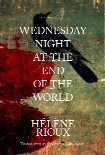
Wednesday Night At The End Of The World
Hélène Rioux
Translated by Jonathan Kaplansky
Cormorant Books
$21.00
paper
250pp
978-1-897151426
Rioux’s novel opens in a late-night neighbourhood restaurant in the Petite Patrie area of Montreal called The End of the World. A snowstorm is gathering outside, while inside the scene unfolds around a group of regular diners and card players composed of middle-aged women and taxi drivers. Their eating, drinking, and playing, the sounds of radio ballads, and an old movie flickering on the TV screen soon make way for a grimmer reality as a sudden crisis moves the action into high gear. It is at this juncture that Rioux lifts us out of the restaurant and takes us on a journey. A string of story segments ensues, each one a self-contained narrative set elsewhere but united in time (the stories all occur on December 21) and with elements that link the far-flung episodes to one another.
Rioux develops her characters from initially two-dimensional figures into complex individuals who nurture vivid imaginations, hopes, dreams, and memories as counterpoints to their mostly dreary, everyday realities. One episode portrays two exotic dancers stranded in a motel and sharing their respective life stories. Their questionable career choices are shown to be subject to deeper aspirations linked to an essentially human pursuit of happiness: the support of loved ones, the purchase of a home, the desire to belong. Another episode brings together a middle-aged Montreal taxi driver vacationing on a Caribbean beach and a young local woman who nurtures dreams of her own by (usually) accommodating those of tourists.
And yet, despite the connections that string these stories together, the isolation and suffering of the individual characters remain evident, as do their respective escapes into the world of dreams, memories, and fantasies. If most of them stay trapped, inert in the face of their real-life predicaments, their imaginations do take flight, allowing for individualist action, albeit on a fictional plane: “Tormented men held women in their arms, secrets were revealed, figures embraced in rose gardens.”
Some readers will be confused by the multiple names and characters, especially as some characters undergo name changes or have names and descriptions very similar to those of other characters. A mysterious unshaven man in a black turtleneck, for example, appears in several of the story segments. At times, he seems to be an already deceased author languishing in purgatory, at others a would-be revolutionary locked up in prison decades ago. In spite of these time and mobility challenges, however, the character crops up in Montreal, Florida, and Mexico City.
Kaplansky’s translation is rendered in fluid prose, conveying the rich and varied imagery of the original text. More rigorous editing, however, would have spared the reader such typos as “carrera-marble,” “Marquis of Sade,” “definately,” and “I’d really liked to have heard him in therapy.” Kaplansky astutely preserves some French elements, including elegantly inverted bilingual sequences (“Gino’s Subs & Pizzas, Free Delivery, Livraison gratuite, 24 Hours a Day, 24 heures par jour”), thereby keeping the text’s origin as well as its setting visible to English readers. The decision in favour of literal translations of frequently recurring phrases (“it seems”/ “it seems to me”), on the other hand, can result in a wooden quality: “The Chinese also wear them, it seems to me.”
Wednesday Night at the End of the World takes the reader on a journey that goes beyond the predictable, delivering surprises as well as mystery. It gives us an inkling of a world of fragmented individuals, held together not by the bonds of kinship, friendship, or solidarity, but by escapist needs and habits. mRb






0 Comments